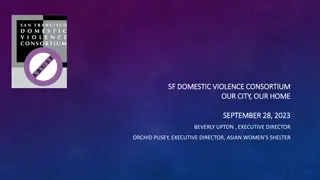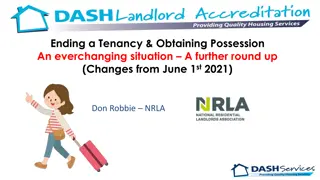Understanding Domestic Violence Provisions in Tenancy Law
This learning material explores definitions of domestic violence, withdrawing from tenancies due to family violence, unlawful acts, and more. It outlines the forms and perpetrators of domestic violence and delves into regulations and legislation regarding tenancy terminations in such cases.
Download Presentation

Please find below an Image/Link to download the presentation.
The content on the website is provided AS IS for your information and personal use only. It may not be sold, licensed, or shared on other websites without obtaining consent from the author. Download presentation by click this link. If you encounter any issues during the download, it is possible that the publisher has removed the file from their server.
E N D
Presentation Transcript
TENANCY LAW PROVISIONS RELATING TO DOMESTIC VIOLENCE WELCOME WE WILL BE STARTING SOON
TODAYS LEARNING Definitions What is Domestic Violence? Withdrawing from Tenancies Damages Unlawful Acts, Antisocial behaviour and Body Corp rules (if time allows) Can we do this better?
DOMESTIC VIOLENCE CAN BE: Physical Sexual Psychological Financial Harming of pets Restricting access to medications or other supports that affect a person s quality of life Any pattern of behaviour which may cause cumulative harm
DOMESTIC VIOLENCE CAN BE INFLICTED BY: Partner or spouse Former partner or spouse Family member Flat mate Carer or Care Giver Anyone in a close personal relationship Members of the same culturally recognised group
WITHDRAWING FROM A TENANCY 56B: Withdrawal from tenancy following family violence (1) A tenant under a fixed-term or periodic tenancy may withdraw from the tenancy by giving at least 2 days notice to the landlord if (a) the notice is accompanied by qualifying evidence that the tenant has been a victim of family violence while a tenant of the premises; and (b) the notice is in the approved form and includes the prescribed information.
THE REGULATIONS Came into force on 29 December 2022 Prior to that date there was no prescribed form After that date, the regulations state the Tenancy Services form must be used We do not know how the Tribunal will rule if the Tenancy Services form is NOT used Cases where the tenancy ended prior to 29 December 2022 should be ruled on in accordance with section 85 (2) of the RTA and guidance in the Legislation Act 2019
THE LEGISLATION ACT 2019 Section 52: Use of approved or prescribed forms A form is not invalid just because it contains minor differences from an approved or a prescribed form as long as the form still has the same effect and is not misleading. Section 10 (1): How to ascertain meaning of legislation The meaning of legislation must be ascertained from its text and in the light of its purpose and its context.
WHAT IS THE INTENT OF SECTION 56B OF THE RTA The Minister responsible for the passing of s 56B, the Honourable Kris Faafoi, Associate Minister of Housing (Public Housing), described the purpose of the provision as follows: The bill also enables a victim of family violence to withdraw from a fixed or periodic tenancy speedily, by giving their landlord two days' notice, along with evidence of the family violence while on the premises. After the termination date, the tenant will not be liable for any further rent. These changes mean that victims have fewer barriers to exiting tenancies quickly in order to seek safety.
WHAT HAPPENS IF PEOPLE DONT USE THE CORRECT FORM AFTER 29 DECEMBER 2022? Short Answer: We don t know. But there is some relief in the RTA. Section 51(4) states that: In a notice to terminate a tenancy, no special form of words shall be required; and no such notice shall be held invalid for any failure to comply strictly with the requirements of subsection (3) so long as the notice is in writing, the intention to terminate the tenancy on a particular date or on the expiry of a particular period is stated clearly in the notice, and that any non- compliance is not such as to mislead or affect unjustly the interests of the recipient.
HOW IS RENT AFFECTED BY A WITHDRAWAL NOTICE UNDER SECTION 56B? The leaving tenant is liable for rent for 2 days following the day they served the notice Any remaining tenants are liable to continue to pay rent Rent is reduced proportionally for a period of 2 weeks after a tenant victim withdraws The weekly rent amount is divided by the previous number of tenants and then the remaining tenants must pay their share of that rent for the following two weeks After 2 weeks the remaining tenants become liable for the full amount of rent These provisions do not apply to tenants paying income related rent who must continue to pay their rent as usual as long as they remain in the property
THE INFORMATION IN THE NEXT SECTION IS HEAVILY INFLUENCED BY AN ARTICLE WRITTEN BY BRIDGETTE TOY-CRONIN: "COMPOUNDING THE ABUSE: FAMILY VIOLENCE, DAMAGES AND THE TENANCY TRIBUNAL" (2020) 29(2) NEW ZEALAND UNIVERSITIES LAW REVIEW 201. Read Bridgette s article in full here: https://ourarchive.otago.ac.nz/handle/10523/10640.
In your groups, consider these two questions: Why does the Tenancy Tribunal treat Family Violence differently from other forms of criminal violence? Is there anything in the RTA which allows for a different interpretation or one that allows both forms of violence to be treated equally?
The drafting of the RTA allows space for an interpretation that both takes into account the context of family violence and the policy attempts to prevent family violence. Such a reading acknowledges that not everyone has the physical and social power to control who comes into their home and what they do once admitted. Interpreting the RTA to recognise the realities of family violence would ensure that tenancy law and practice supports the strategy of keeping victims of family violence safe. Bridgette Toy-Cronin "Compounding the abuse: Family violence, damages and the Tenancy Tribunal" (2020) 29(2) New Zealand Universities Law Review 201.
KEENAN V MOTTRAM A tenant's liability for damage only extends to his own acts or omissions or those of others on the premises with his permission (s 41(1)). In the absence of evidence of negligence on the part of the tenant with respect to security matters, a tenant is certainly not responsible for damage caused by a burglar.
FAMILY VIOLENCE VS OTHER CRIMINAL ACTIVITY A tenant's liability for damage only extends to his own acts or omissions or those of others on the premises with his permission (s 41(1)). In the absence of evidence of negligence on the part of the tenant with respect to security matters, a tenant is certainly not responsible for damage caused by a burglar. Keenan v Mottram The damage to the windows and doors was admitted to be due to domestic violence with her partner trying to gain access by jimmying the locks . (the sole tenant was found liable for damages to windows ($516.35). C v J [2018] NZTT Hamilton 4121356
INCONSISTENT APPLICATION Housing New Zealand v McKelvey TT Palmerston North TT268/96, 11 April 1996 The hole in the wall] was done by her ex-partner when he was at the house and became very angry. The police were called. The Residential Tenancies Act states in s 41(2) that where any other person intentionally or carelessly damages the premises the tenant shall be presumed to have permitted that person to be in the premises unless the tenant proves that she took all reasonable steps to [in this case] eject that person from the premises. The Tribunal holds that, in the situation where someone is violent and is damaging the premises, calling the police is making a reasonable attempt to protect both the occupants and the premises. Ms McKelvey did this. The liability for the repair and re-decoration of the wall lies with the person who did the damage.
INCONSISTENT APPLICATION D v T [2018] NZTT Napier 4140165 The order records that the police were called to the property during at least one incident, but the adjudicator found the tenant responsible because she did not take out a trespass order. J v L [2019] NZTT Rotorua 4199813 The tenant was unable to provide any evidence that that she took all reasonable steps to prevent that person from entering the premises or to eject that person from the premises (see section 41(2) RTA) therefore she has not disproved liability for the damage.























